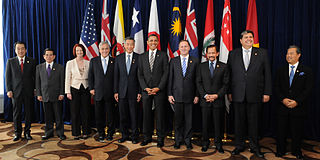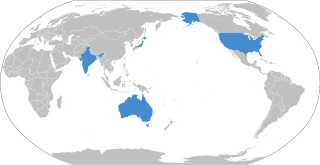
Asia-Pacific Economic Cooperation is an inter-governmental forum for 21 member economies in the Pacific Rim that promotes free trade throughout the Asia-Pacific region. Following the success of ASEAN's series of post-ministerial conferences launched in the mid-1980s, APEC started in 1989, in response to the growing interdependence of Asia-Pacific economies and the advent of regional trade blocs in other parts of the world; it aimed to establish new markets for agricultural products and raw materials beyond Europe. Headquartered in Singapore, APEC is recognized as one of the highest-level multilateral blocs and oldest forums in the Asia-Pacific region, and exerts significant global influence.

The Indo-Pacific is a vast biogeographic region of Earth.

The economy of Asia comprises about 4.7 billion people living in 50 different nations. Asia is the fastest growing economic region, as well as the largest continental economy by both GDP Nominal and PPP in the world. Moreover, Asia is the site of some of the world's longest modern economic booms.

The Trans-Pacific Partnership (TPP), or Trans-Pacific Partnership Agreement (TPPA), was a proposed trade agreement between 12 Pacific Rim economies: Australia, Brunei, Canada, Chile, Japan, Malaysia, Mexico, New Zealand, Peru, Singapore, Vietnam, and the United States. In the United States, the proposal was signed on 4 February 2016 but not ratified as a result of significant domestic political opposition. After taking office, the newly elected President Donald Trump formally withdrew the United States from TPP in January 2017, therefore ensuring the TPP could not be ratified as required and did not enter into force. The remaining countries negotiated a new trade agreement called Comprehensive and Progressive Agreement for Trans-Pacific Partnership, which incorporated most of the provisions of the TPP and which entered into force on 30 December 2018.

The United States foreign policy toward the People's Republic of China originated during the Cold War. At that time, the U.S. had a containment policy against communist states. The leaked Pentagon Papers indicated the efforts by the U.S. to contain China through military actions undertaken in the Vietnam War. The containment policy centered around an island chain strategy. President Richard Nixon's China rapprochement signaled a shift in focus to gain leverage in containing the Soviet Union. Formal diplomatic ties between the U.S. and China were established in 1979, and with normalized trade relations since 2000, the U.S. and China have been linked by closer economic ties and more cordial relations. In his first term as U.S. president, Barack Obama said, "We want China to succeed and prosper. It's good for the United States if China continues on the path of development that it's on".
The East Asia Economic Caucus (EAEC) or East Asia Economic Group (EAEG) was a regional free trade zone (FTA) proposed in 1997 by Malaysian Prime Minister Mahathir Mohamad and encompasses most nations of East and Southeast Asia (ESEA). However, Japan at the time refused participation due to the exclusion of the United States, which at the time had tariffs on each other, has an economy too deeply interlinked through trade, and was still reeling from the effects of the Japanese asset price bubble. They also added that they were already members of the Asia-Pacific Economic Cooperation (APEC) and many other notable regional organizations in ESEA. South Korea was also extremely dissatisfied with the idea of placing Japan at the center of the proposed organization due to historical connotations.

New Zealand is party to 14 free trade agreements (FTAs) worldwide. Together they accounted for over 70% of New Zealand's trade in 2023.

The Act East policy is an effort by the Government of India to cultivate extensive economic and strategic relations with the nations of Southeast Asia to bolster its standing as a regional power and a counterweight to the strategic influence of the People's Republic of China.

APEC United States 2011 was a series of political meetings around the United States between the 21 member economies of the Asia-Pacific Economic Cooperation during 2011. It culminated in the 19th APEC Economic Leaders' Meeting held at the Hawaii Convention Center in Honolulu, Hawaii from November 12–13, 2011. The United States last hosted an APEC summit at the 1993 summit in Seattle. President Barack Obama, a Honolulu native, and First Lady Michelle Obama hosted the other leaders and spouses.

The Berkeley APEC Study Center (BASC) is a research center at the University of California, Berkeley. Created in 1996 in response to an initiative by U.S. President Bill Clinton, the center undertakes research, disseminates information and facilitates discussion on issue related to APEC involving political, economic and business trends in the Asia-Pacific region.

The Quad is a grouping of Australia, India, Japan, and the United States that is maintained by talks between member countries. The grouping was initiated in 2007 by Japanese Prime Minister Shinzo Abe, with the support of Australian Prime Minister John Howard, Indian Prime Minister Manmohan Singh and U.S. Vice President Dick Cheney. The dialogue was paralleled by joint military exercises of an unprecedented scale, titled Exercise Malabar. The diplomatic and military arrangement was widely viewed as a response to increased Chinese economic and military power.

The Regional Comprehensive Economic Partnership is a free trade agreement among the Asia-Pacific countries of Australia, Brunei, Cambodia, China, Indonesia, Japan, South Korea, Laos, Malaysia, Myanmar, New Zealand, the Philippines, Singapore, Thailand, and Vietnam. The 15 member countries account for about 30% of the world's population and 30% of global GDP, making it the largest trade bloc in history. Signed in November 2020, RCEP is the first free trade agreement among the largest economies in Asia, including China, Indonesia, Japan, and South Korea.
The negotiations for the Trans-Pacific Partnership Agreement were held between 12 countries between 2008 and 2015. The negotiations were aimed at obtaining an agreement between the Trans-Pacific Strategic Economic Partnership Agreement parties Brunei, Chile, Singapore and New Zealand, as well as the Australia and the United States.

The Comprehensive and Progressive Agreement for Trans-Pacific Partnership (CPTPP), initially abbreviated as TPP11 or TPP-11, is a trade agreement between Australia, Brunei, Canada, Chile, Japan, Malaysia, Mexico, New Zealand, Peru, Singapore, and Vietnam. It evolved from the Trans-Pacific Partnership (TPP), which was never ratified due to the withdrawal of the United States. The eleven members have combined economies representing 13.4 percent of global gross domestic product, at approximately US$13.5 trillion, making the CPTPP one of the world's largest free trade areas by GDP, along with the United States–Mexico–Canada Agreement, the European single market, and the Regional Comprehensive Economic Partnership. The United Kingdom and the present members formally signed an accession protocol on 16 July 2023, and will join the agreement when it has been ratified by all parties, or after 15 months if the UK and a majority of CPTPP parties have ratified it.

Free and Open Indo-Pacific is an umbrella term that encompasses Indo-Pacific-specific strategies of countries with similar interests in the region. The concept, with its origins in Weimar German geopolitics, has been revived since 2006 through Japanese initiatives and American cooperation.

The Partnership for Global Infrastructure and Investment (PGII) is a collaborative effort by Group of Seven (G7) to fund infrastructure projects in developing nations based on the trust principles of the Blue Dot Network. It is intended to be the bloc's counter to China's Belt and Road Initiative and a key component of the "Biden Doctrine".

Australia is party to 18 free trade agreements (FTAs) worldwide covering 30 economies.

The Indo-Pacific strategy is the U.S. Government's vision for a free, open, and secure Indo-Pacific region in which countries of the Indo-Pacific are empowered to tackle 21st-century challenges and seize emerging opportunities. Bangladesh, strategically located in the Bay of Bengal, serves as a gateway to South and Southeast Asia. Its position makes it a key participant in the Indo-Pacific strategy of the United States, India, Japan, and Australia. Bangladesh views stability and prosperity in the Indo-Pacific as essential for becoming a modern, developed nation. The country aims for a free, open, and inclusive Indo-Pacific to ensure long-term resilience and shared prosperity for all.


















